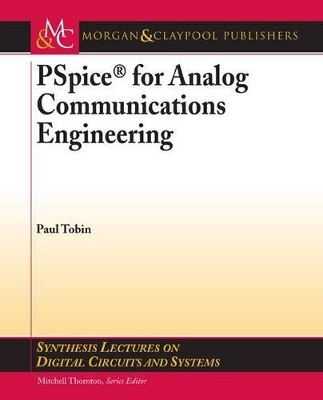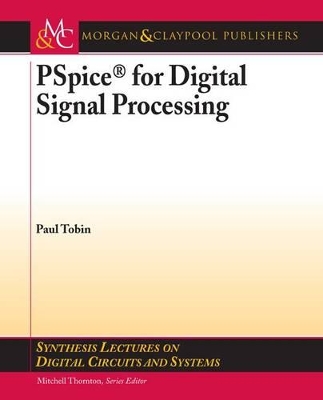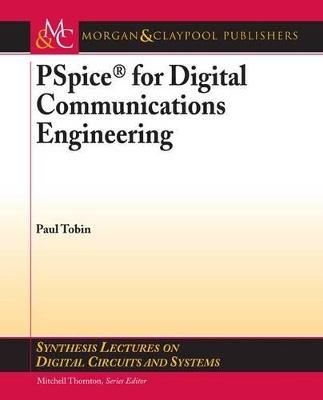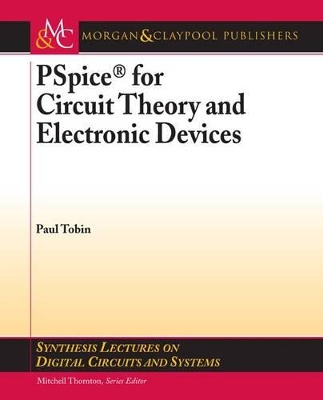Synthesis Lectures on Digital Circuits and Systems
5 total works
In PSpice for Analog Communications Engineering we simulate the difficult principles of analog modulation using the superb free simulation software Cadence Orcad PSpice V10.5. While use is made of analog behavioral model parts (ABM), we use actual circuitry in most of the simulation circuits. For example, we use the 4-quadrant multiplier IC AD633 as a modulator and import real speech as the modulating source and look at the trapezoidal method for measuring the modulation index. Modulation is the process of relocating signals to different parts of the radio frequency spectrum by modifying certain parameters of the carrier in accordance with the modulating/information signals. In amplitude modulation, the modulating source changes the carrier amplitude, but in frequency modulation it causes the carrier frequency to change (and in phase modulation it's the carrier phase).
The digital equivalent of these modulation techniques are examined in PSpice for Digital communications Engineering where we examine QAM, FSK, PSK and variants. We examine a range of oscillators and plot Nyquist diagrams showing themarginal stability of these systems. The superhetrodyne principle, the backbone of modern receivers is simulated using discrete components followed by simulating complete AM and FM receivers. In this exercise we examine the problems ofmatching individual stages and the use of double-tuned RF circuits to accommodate the large FM signal bandwidth.
The digital equivalent of these modulation techniques are examined in PSpice for Digital communications Engineering where we examine QAM, FSK, PSK and variants. We examine a range of oscillators and plot Nyquist diagrams showing themarginal stability of these systems. The superhetrodyne principle, the backbone of modern receivers is simulated using discrete components followed by simulating complete AM and FM receivers. In this exercise we examine the problems ofmatching individual stages and the use of double-tuned RF circuits to accommodate the large FM signal bandwidth.
PSpice for Digital Signal Processing is the last in a series of five books using Cadence Orcad PSpice version 10.5 and introduces a very novel approach to learning digital signal processing (DSP). DSP is traditionally taught using Matlab/Simulink software but has some inherent weaknesses for students particularly at the introductory level. The `plug in variables and play' nature of these software packages can lure the student into thinking they possess an understanding they don't actually have because these systems produce results quicklywithout revealing what is going on. However, it must be said that, for advanced level work Matlab/Simulink really excel. In this book we start by examining basic signals starting with sampled signals and dealing with the concept of digital frequency. The delay part, which is the heart of DSP, is explained and applied initially to simple FIR and IIR filters.
We examine linear time invariant systems starting with the difference equation and applying the z-transform to produce a range of filter type i.e. low-pass, high-pass and bandpass. The important concept of convolution is examined and here we demonstrate the usefulness of the 'log' command in Probe for giving the correct display to demonstrate the 'flip n slip' method. Digital oscillators, including quadrature carrier generation, are then examined. Several filter design methods are considered and include the bilinear transform, impulse invariant, and window techniques. Included also is a treatment of the raised-cosine family of filters.
A range of DSP applications are then considered and include the Hilbert transform, single sideband modulator using the Hilbert transform and quad oscillators, integrators and differentiators. Decimation and interpolation are simulated to demonstrate the usefulness of the multi-sampling environment. Decimation is also applied in a treatment on digital receivers. Lastly, we look at some musical applications for DSP such as reverberation/echo using real-world signals imported into PSpice using the program Wav2Ascii. The zero-forcing equalizer is dealt with in a simplistic manner and illustrates the effectiveness of equalizing signals in a receiver after transmission.
We examine linear time invariant systems starting with the difference equation and applying the z-transform to produce a range of filter type i.e. low-pass, high-pass and bandpass. The important concept of convolution is examined and here we demonstrate the usefulness of the 'log' command in Probe for giving the correct display to demonstrate the 'flip n slip' method. Digital oscillators, including quadrature carrier generation, are then examined. Several filter design methods are considered and include the bilinear transform, impulse invariant, and window techniques. Included also is a treatment of the raised-cosine family of filters.
A range of DSP applications are then considered and include the Hilbert transform, single sideband modulator using the Hilbert transform and quad oscillators, integrators and differentiators. Decimation and interpolation are simulated to demonstrate the usefulness of the multi-sampling environment. Decimation is also applied in a treatment on digital receivers. Lastly, we look at some musical applications for DSP such as reverberation/echo using real-world signals imported into PSpice using the program Wav2Ascii. The zero-forcing equalizer is dealt with in a simplistic manner and illustrates the effectiveness of equalizing signals in a receiver after transmission.
PSpice for Digital Communications Engineering shows how to simulate digital communication systems and modulation methods using the very powerful Cadence Orcad PSpice version 10.5 suite of software programs. Fourier series and Fourier transform are applied to signals to set the ground work for the modulation techniques introduced in later chapters. Various baseband signals, including duo-binary baseband signaling, are generated and the spectra are examined to detail the unsuitability of these signals for accessing the public switched network. Pulse code modulation and time-division multiplexing circuits are examined and simulated where sampling and quantization noise topics are discussed. We construct a single-channel PCM system from transmission to receiver i.e. end-to-end, and import real speech signals to examine the problems associated with aliasing, sample and hold.
Companding is addressed here and we look at the A and mu law characteristics for achieving better signal to quantization noise ratios. Several types of delta modulators are examined and also the concept of time divisionmultiplexing is considered. Multi-level signaling techniques such as QPSK andQAMare analyzed and simulated and 'home-made meters', such as scatter and eye meters, are used to assess the performance of these modulation systems in the presence of noise. The raised-cosine family of filters for shaping data before transmission is examined in depth where bandwidth efficiency and channel capacity is discussed. We plot several graphs in Probe to compare the efficiency of these systems. Direct spread spectrum is the last topic to be examined and simulated to show the advantages of spreading the signal over a wide bandwidth and giving good signal security at the same time.
Companding is addressed here and we look at the A and mu law characteristics for achieving better signal to quantization noise ratios. Several types of delta modulators are examined and also the concept of time divisionmultiplexing is considered. Multi-level signaling techniques such as QPSK andQAMare analyzed and simulated and 'home-made meters', such as scatter and eye meters, are used to assess the performance of these modulation systems in the presence of noise. The raised-cosine family of filters for shaping data before transmission is examined in depth where bandwidth efficiency and channel capacity is discussed. We plot several graphs in Probe to compare the efficiency of these systems. Direct spread spectrum is the last topic to be examined and simulated to show the advantages of spreading the signal over a wide bandwidth and giving good signal security at the same time.
In this book, PSpice for Filters and Transmission Lines, we examine a range of active and passive filters where each design is simulated using the latest Cadence Orcad V10.5 PSpice capture software. These filters cannot match the very high order digital signal processing (DSP) filters considered in PSpice for Digital Signal Processing, but nevertheless these filters have many uses. The active filters considered were designed using Butterworth and Chebychev approximation loss functions rather than using the `cookbook approach' so that the final design will meet a given specification in an exacting manner. Switched-capacitor filter circuits are examined and here we see how useful PSpice/Probe is in demonstrating how these filters, filter, as it were. Two-port networks are discussed as an introduction to transmission lines and, using a series of problems, we demonstrate quarter-wave and single-stub matching. The concept of time domain reflectrometry as a fault location tool on transmission lines is then examined. In the last chapter we discuss the technique of importing and exporting speech signals into a PSpice schematic using a tailored-made program Wav2ascii. This is a novel technique that greatly extends the simulation boundaries of PSpice. Various digital circuits are also examined at the end of this chapter to demonstrate the use of the bus structure and other techniques.
PSpice for Circuit Theory and Electronic Devices is one of a series of five PSpice books and introduces the latest Cadence Orcad PSpice version 10.5 by simulating a range of DC and AC exercises. It is aimed primarily at those wishing to get up to speed with this version but will be of use to high school students, undergraduate students, and of course, lecturers. Circuit theorems are applied to a range of circuits and the calculations by hand after analysis are then compared to the simulated results. The Laplace transform and the s-plane are used to analyze CR and LR circuits where transient signals are involved. Here, the Probe output graphs demonstrate what a great learning tool PSpice is by providing the reader with a visual verification of any theoretical calculations. Series and parallel-tuned resonant circuits are investigated where the difficult concepts of dynamic impedance and selectivity are best understood by sweeping different circuit parameters through a range of values.
Obtaining semiconductor device characteristics as a laboratory exercise has fallen out of favour of late, but nevertheless, is still a useful exercise for understanding or modelling semiconductor devices. Inverting and non-inverting operational amplifiers characteristics such as gain-bandwidth are investigated and we will see the dependency of bandwidth on the gain using the performance analysis facility. Power amplifiers are examined where PSpice/Probe demonstrates very nicely the problems of cross-over distortion and other problems associated with power transistors. We examine power supplies and the problems of regulation, ground bounce, and power factor correction. Lastly, we look at MOSFET device characteristics and show how these devices are used to form basic CMOS logic gates such as NAND and NOR gates.
Obtaining semiconductor device characteristics as a laboratory exercise has fallen out of favour of late, but nevertheless, is still a useful exercise for understanding or modelling semiconductor devices. Inverting and non-inverting operational amplifiers characteristics such as gain-bandwidth are investigated and we will see the dependency of bandwidth on the gain using the performance analysis facility. Power amplifiers are examined where PSpice/Probe demonstrates very nicely the problems of cross-over distortion and other problems associated with power transistors. We examine power supplies and the problems of regulation, ground bounce, and power factor correction. Lastly, we look at MOSFET device characteristics and show how these devices are used to form basic CMOS logic gates such as NAND and NOR gates.




